Strategies and Plans to Improve Communication at All Levels Report
VerifiedAdded on 2021/06/18
|14
|4521
|145
Report
AI Summary
This report examines strategies and plans to improve communication at all levels within a multinational organization. It explores the use of social media as a strategic communication tool, highlighting its benefits such as direct interaction with clients, cost-effectiveness, and its role in internet marketing. The report also addresses the challenges associated with social media use, including the spread of false information and the control of information outflow. Furthermore, it emphasizes the importance of a comprehensive feedback mechanism for measuring communication effectiveness, gathering information, and facilitating decision-making and problem-solving. Finally, the report discusses the significance of intercultural communication, outlining the challenges and strategies for improvement within a globalized organizational context. Recommendations are provided for efficient social media use, improved organizational feedback, and enhanced intercultural communication practices.
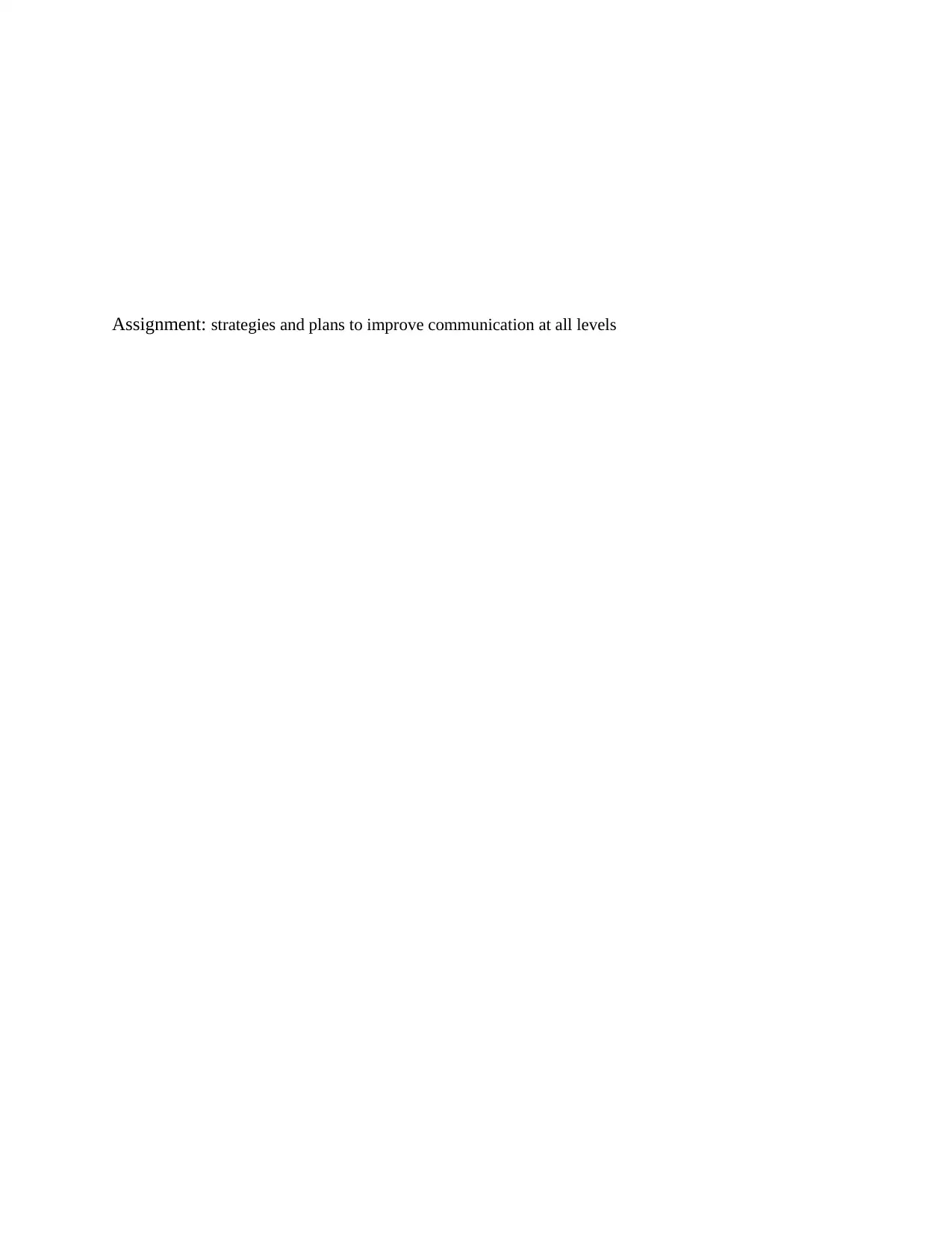
Assignment: strategies and plans to improve communication at all levels
Paraphrase This Document
Need a fresh take? Get an instant paraphrase of this document with our AI Paraphraser
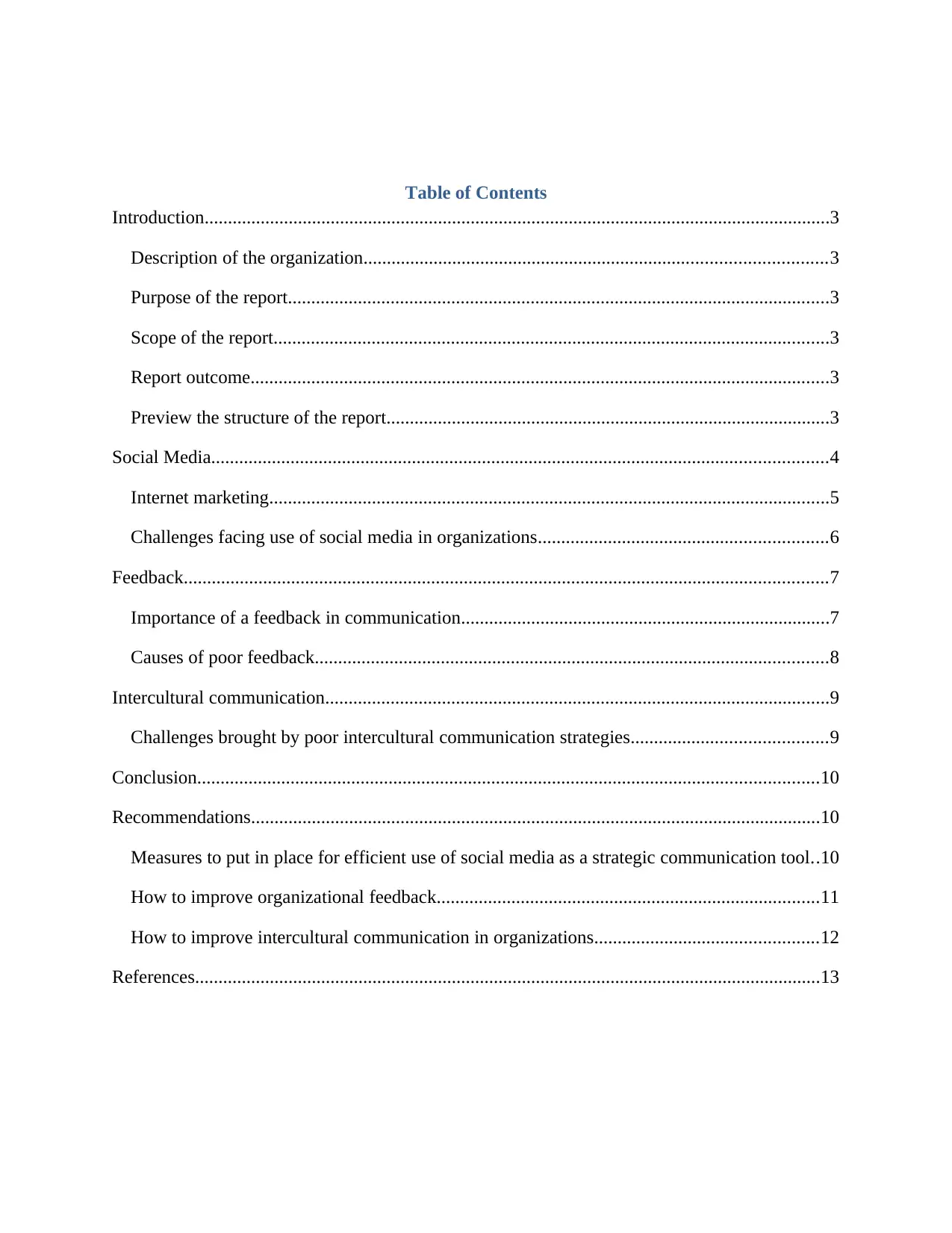
Table of Contents
Introduction......................................................................................................................................3
Description of the organization...................................................................................................3
Purpose of the report....................................................................................................................3
Scope of the report.......................................................................................................................3
Report outcome............................................................................................................................3
Preview the structure of the report...............................................................................................3
Social Media....................................................................................................................................4
Internet marketing........................................................................................................................5
Challenges facing use of social media in organizations..............................................................6
Feedback..........................................................................................................................................7
Importance of a feedback in communication...............................................................................7
Causes of poor feedback..............................................................................................................8
Intercultural communication............................................................................................................9
Challenges brought by poor intercultural communication strategies..........................................9
Conclusion.....................................................................................................................................10
Recommendations..........................................................................................................................10
Measures to put in place for efficient use of social media as a strategic communication tool..10
How to improve organizational feedback..................................................................................11
How to improve intercultural communication in organizations................................................12
References......................................................................................................................................13
Introduction......................................................................................................................................3
Description of the organization...................................................................................................3
Purpose of the report....................................................................................................................3
Scope of the report.......................................................................................................................3
Report outcome............................................................................................................................3
Preview the structure of the report...............................................................................................3
Social Media....................................................................................................................................4
Internet marketing........................................................................................................................5
Challenges facing use of social media in organizations..............................................................6
Feedback..........................................................................................................................................7
Importance of a feedback in communication...............................................................................7
Causes of poor feedback..............................................................................................................8
Intercultural communication............................................................................................................9
Challenges brought by poor intercultural communication strategies..........................................9
Conclusion.....................................................................................................................................10
Recommendations..........................................................................................................................10
Measures to put in place for efficient use of social media as a strategic communication tool..10
How to improve organizational feedback..................................................................................11
How to improve intercultural communication in organizations................................................12
References......................................................................................................................................13
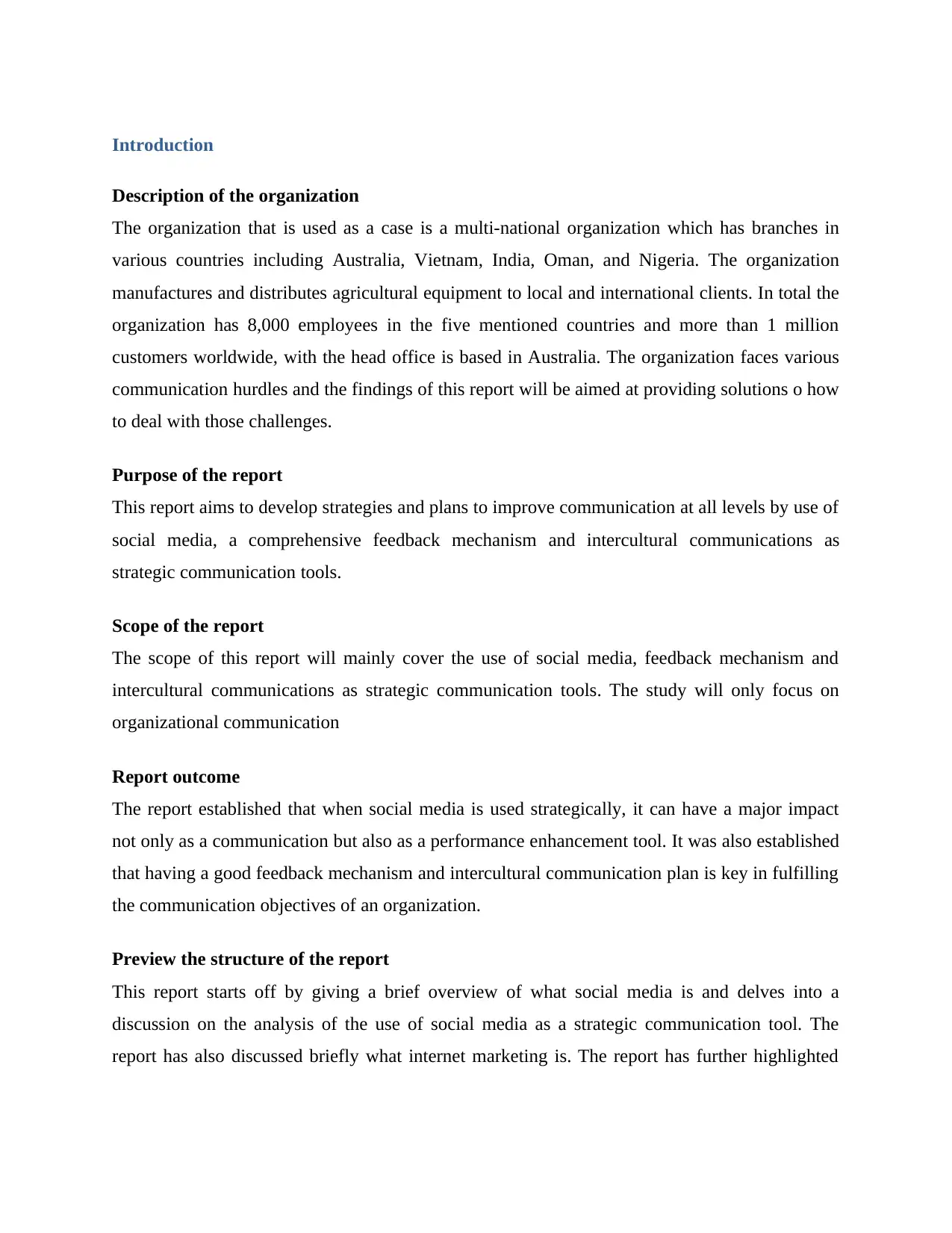
Introduction
Description of the organization
The organization that is used as a case is a multi-national organization which has branches in
various countries including Australia, Vietnam, India, Oman, and Nigeria. The organization
manufactures and distributes agricultural equipment to local and international clients. In total the
organization has 8,000 employees in the five mentioned countries and more than 1 million
customers worldwide, with the head office is based in Australia. The organization faces various
communication hurdles and the findings of this report will be aimed at providing solutions o how
to deal with those challenges.
Purpose of the report
This report aims to develop strategies and plans to improve communication at all levels by use of
social media, a comprehensive feedback mechanism and intercultural communications as
strategic communication tools.
Scope of the report
The scope of this report will mainly cover the use of social media, feedback mechanism and
intercultural communications as strategic communication tools. The study will only focus on
organizational communication
Report outcome
The report established that when social media is used strategically, it can have a major impact
not only as a communication but also as a performance enhancement tool. It was also established
that having a good feedback mechanism and intercultural communication plan is key in fulfilling
the communication objectives of an organization.
Preview the structure of the report
This report starts off by giving a brief overview of what social media is and delves into a
discussion on the analysis of the use of social media as a strategic communication tool. The
report has also discussed briefly what internet marketing is. The report has further highlighted
Description of the organization
The organization that is used as a case is a multi-national organization which has branches in
various countries including Australia, Vietnam, India, Oman, and Nigeria. The organization
manufactures and distributes agricultural equipment to local and international clients. In total the
organization has 8,000 employees in the five mentioned countries and more than 1 million
customers worldwide, with the head office is based in Australia. The organization faces various
communication hurdles and the findings of this report will be aimed at providing solutions o how
to deal with those challenges.
Purpose of the report
This report aims to develop strategies and plans to improve communication at all levels by use of
social media, a comprehensive feedback mechanism and intercultural communications as
strategic communication tools.
Scope of the report
The scope of this report will mainly cover the use of social media, feedback mechanism and
intercultural communications as strategic communication tools. The study will only focus on
organizational communication
Report outcome
The report established that when social media is used strategically, it can have a major impact
not only as a communication but also as a performance enhancement tool. It was also established
that having a good feedback mechanism and intercultural communication plan is key in fulfilling
the communication objectives of an organization.
Preview the structure of the report
This report starts off by giving a brief overview of what social media is and delves into a
discussion on the analysis of the use of social media as a strategic communication tool. The
report has also discussed briefly what internet marketing is. The report has further highlighted
⊘ This is a preview!⊘
Do you want full access?
Subscribe today to unlock all pages.

Trusted by 1+ million students worldwide
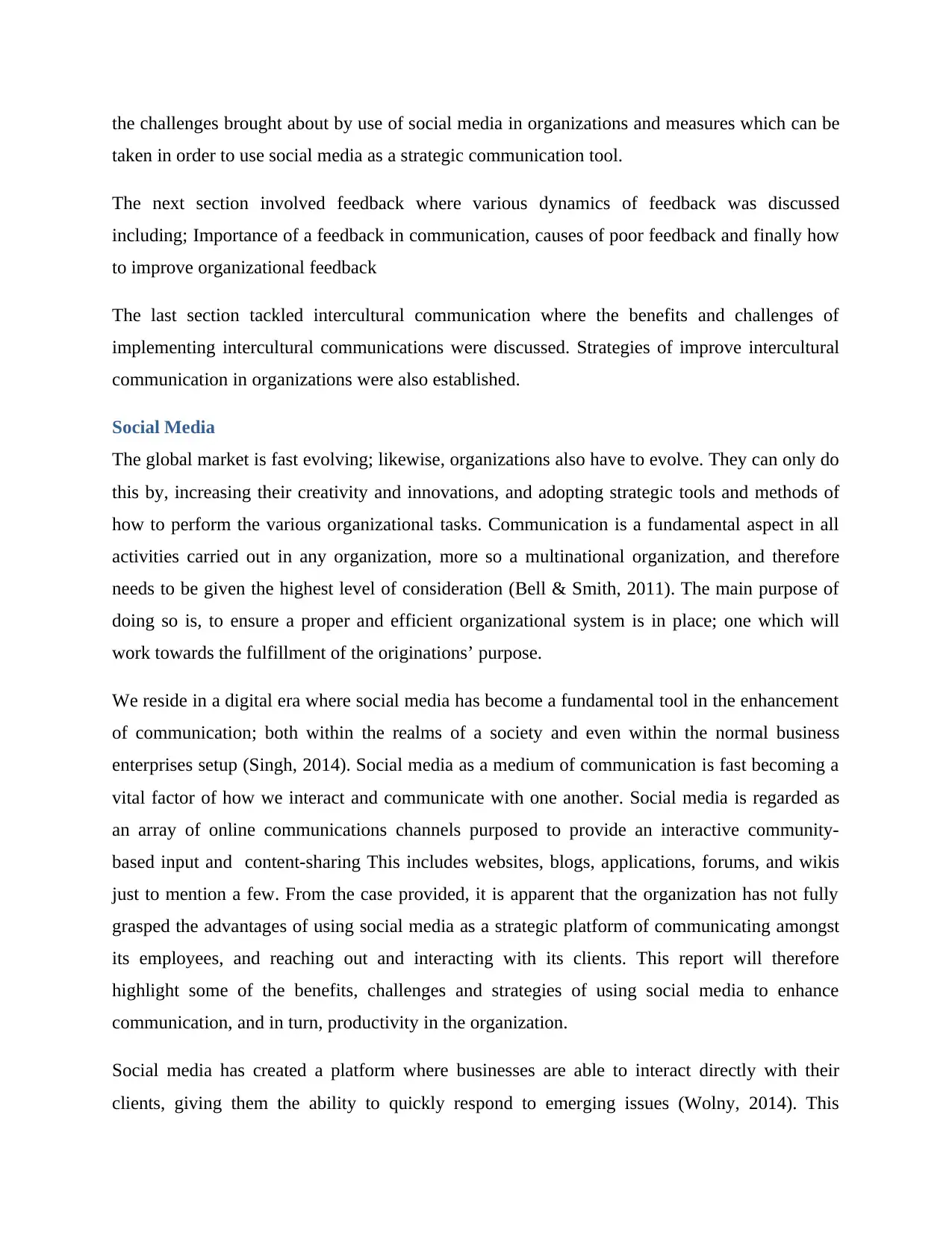
the challenges brought about by use of social media in organizations and measures which can be
taken in order to use social media as a strategic communication tool.
The next section involved feedback where various dynamics of feedback was discussed
including; Importance of a feedback in communication, causes of poor feedback and finally how
to improve organizational feedback
The last section tackled intercultural communication where the benefits and challenges of
implementing intercultural communications were discussed. Strategies of improve intercultural
communication in organizations were also established.
Social Media
The global market is fast evolving; likewise, organizations also have to evolve. They can only do
this by, increasing their creativity and innovations, and adopting strategic tools and methods of
how to perform the various organizational tasks. Communication is a fundamental aspect in all
activities carried out in any organization, more so a multinational organization, and therefore
needs to be given the highest level of consideration (Bell & Smith, 2011). The main purpose of
doing so is, to ensure a proper and efficient organizational system is in place; one which will
work towards the fulfillment of the originations’ purpose.
We reside in a digital era where social media has become a fundamental tool in the enhancement
of communication; both within the realms of a society and even within the normal business
enterprises setup (Singh, 2014). Social media as a medium of communication is fast becoming a
vital factor of how we interact and communicate with one another. Social media is regarded as
an array of online communications channels purposed to provide an interactive community-
based input and content-sharing This includes websites, blogs, applications, forums, and wikis
just to mention a few. From the case provided, it is apparent that the organization has not fully
grasped the advantages of using social media as a strategic platform of communicating amongst
its employees, and reaching out and interacting with its clients. This report will therefore
highlight some of the benefits, challenges and strategies of using social media to enhance
communication, and in turn, productivity in the organization.
Social media has created a platform where businesses are able to interact directly with their
clients, giving them the ability to quickly respond to emerging issues (Wolny, 2014). This
taken in order to use social media as a strategic communication tool.
The next section involved feedback where various dynamics of feedback was discussed
including; Importance of a feedback in communication, causes of poor feedback and finally how
to improve organizational feedback
The last section tackled intercultural communication where the benefits and challenges of
implementing intercultural communications were discussed. Strategies of improve intercultural
communication in organizations were also established.
Social Media
The global market is fast evolving; likewise, organizations also have to evolve. They can only do
this by, increasing their creativity and innovations, and adopting strategic tools and methods of
how to perform the various organizational tasks. Communication is a fundamental aspect in all
activities carried out in any organization, more so a multinational organization, and therefore
needs to be given the highest level of consideration (Bell & Smith, 2011). The main purpose of
doing so is, to ensure a proper and efficient organizational system is in place; one which will
work towards the fulfillment of the originations’ purpose.
We reside in a digital era where social media has become a fundamental tool in the enhancement
of communication; both within the realms of a society and even within the normal business
enterprises setup (Singh, 2014). Social media as a medium of communication is fast becoming a
vital factor of how we interact and communicate with one another. Social media is regarded as
an array of online communications channels purposed to provide an interactive community-
based input and content-sharing This includes websites, blogs, applications, forums, and wikis
just to mention a few. From the case provided, it is apparent that the organization has not fully
grasped the advantages of using social media as a strategic platform of communicating amongst
its employees, and reaching out and interacting with its clients. This report will therefore
highlight some of the benefits, challenges and strategies of using social media to enhance
communication, and in turn, productivity in the organization.
Social media has created a platform where businesses are able to interact directly with their
clients, giving them the ability to quickly respond to emerging issues (Wolny, 2014). This
Paraphrase This Document
Need a fresh take? Get an instant paraphrase of this document with our AI Paraphraser
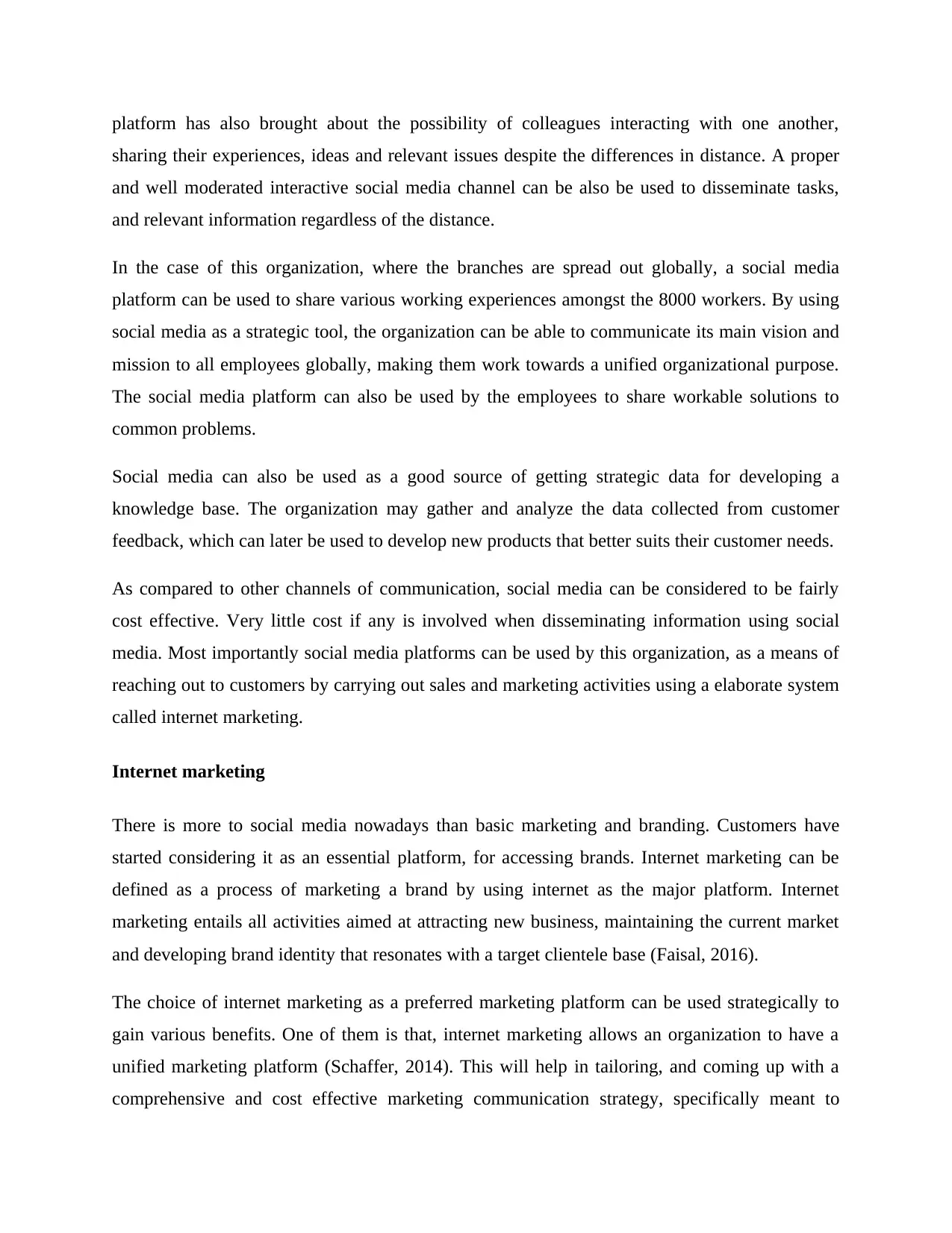
platform has also brought about the possibility of colleagues interacting with one another,
sharing their experiences, ideas and relevant issues despite the differences in distance. A proper
and well moderated interactive social media channel can be also be used to disseminate tasks,
and relevant information regardless of the distance.
In the case of this organization, where the branches are spread out globally, a social media
platform can be used to share various working experiences amongst the 8000 workers. By using
social media as a strategic tool, the organization can be able to communicate its main vision and
mission to all employees globally, making them work towards a unified organizational purpose.
The social media platform can also be used by the employees to share workable solutions to
common problems.
Social media can also be used as a good source of getting strategic data for developing a
knowledge base. The organization may gather and analyze the data collected from customer
feedback, which can later be used to develop new products that better suits their customer needs.
As compared to other channels of communication, social media can be considered to be fairly
cost effective. Very little cost if any is involved when disseminating information using social
media. Most importantly social media platforms can be used by this organization, as a means of
reaching out to customers by carrying out sales and marketing activities using a elaborate system
called internet marketing.
Internet marketing
There is more to social media nowadays than basic marketing and branding. Customers have
started considering it as an essential platform, for accessing brands. Internet marketing can be
defined as a process of marketing a brand by using internet as the major platform. Internet
marketing entails all activities aimed at attracting new business, maintaining the current market
and developing brand identity that resonates with a target clientele base (Faisal, 2016).
The choice of internet marketing as a preferred marketing platform can be used strategically to
gain various benefits. One of them is that, internet marketing allows an organization to have a
unified marketing platform (Schaffer, 2014). This will help in tailoring, and coming up with a
comprehensive and cost effective marketing communication strategy, specifically meant to
sharing their experiences, ideas and relevant issues despite the differences in distance. A proper
and well moderated interactive social media channel can be also be used to disseminate tasks,
and relevant information regardless of the distance.
In the case of this organization, where the branches are spread out globally, a social media
platform can be used to share various working experiences amongst the 8000 workers. By using
social media as a strategic tool, the organization can be able to communicate its main vision and
mission to all employees globally, making them work towards a unified organizational purpose.
The social media platform can also be used by the employees to share workable solutions to
common problems.
Social media can also be used as a good source of getting strategic data for developing a
knowledge base. The organization may gather and analyze the data collected from customer
feedback, which can later be used to develop new products that better suits their customer needs.
As compared to other channels of communication, social media can be considered to be fairly
cost effective. Very little cost if any is involved when disseminating information using social
media. Most importantly social media platforms can be used by this organization, as a means of
reaching out to customers by carrying out sales and marketing activities using a elaborate system
called internet marketing.
Internet marketing
There is more to social media nowadays than basic marketing and branding. Customers have
started considering it as an essential platform, for accessing brands. Internet marketing can be
defined as a process of marketing a brand by using internet as the major platform. Internet
marketing entails all activities aimed at attracting new business, maintaining the current market
and developing brand identity that resonates with a target clientele base (Faisal, 2016).
The choice of internet marketing as a preferred marketing platform can be used strategically to
gain various benefits. One of them is that, internet marketing allows an organization to have a
unified marketing platform (Schaffer, 2014). This will help in tailoring, and coming up with a
comprehensive and cost effective marketing communication strategy, specifically meant to
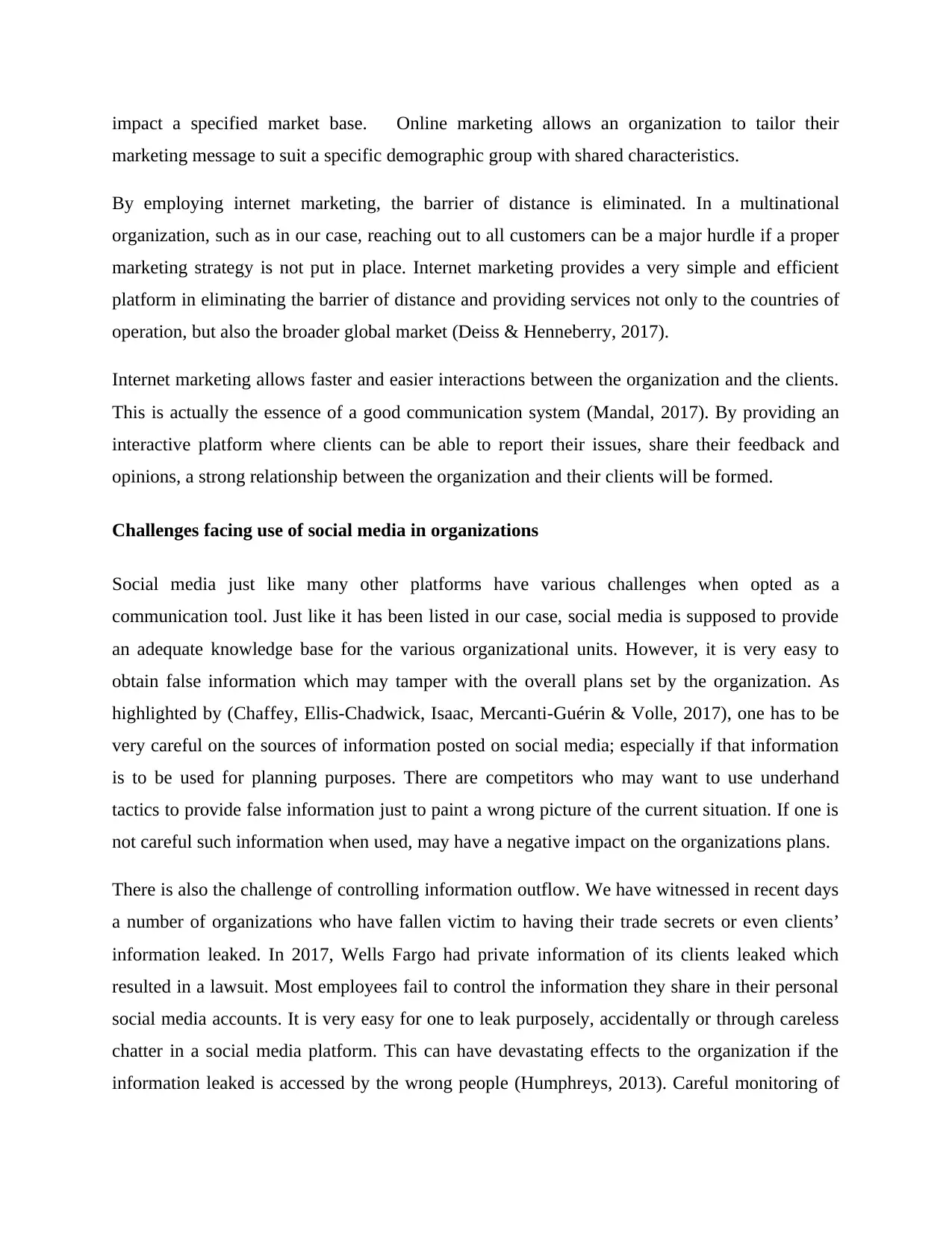
impact a specified market base. Online marketing allows an organization to tailor their
marketing message to suit a specific demographic group with shared characteristics.
By employing internet marketing, the barrier of distance is eliminated. In a multinational
organization, such as in our case, reaching out to all customers can be a major hurdle if a proper
marketing strategy is not put in place. Internet marketing provides a very simple and efficient
platform in eliminating the barrier of distance and providing services not only to the countries of
operation, but also the broader global market (Deiss & Henneberry, 2017).
Internet marketing allows faster and easier interactions between the organization and the clients.
This is actually the essence of a good communication system (Mandal, 2017). By providing an
interactive platform where clients can be able to report their issues, share their feedback and
opinions, a strong relationship between the organization and their clients will be formed.
Challenges facing use of social media in organizations
Social media just like many other platforms have various challenges when opted as a
communication tool. Just like it has been listed in our case, social media is supposed to provide
an adequate knowledge base for the various organizational units. However, it is very easy to
obtain false information which may tamper with the overall plans set by the organization. As
highlighted by (Chaffey, Ellis-Chadwick, Isaac, Mercanti-Guérin & Volle, 2017), one has to be
very careful on the sources of information posted on social media; especially if that information
is to be used for planning purposes. There are competitors who may want to use underhand
tactics to provide false information just to paint a wrong picture of the current situation. If one is
not careful such information when used, may have a negative impact on the organizations plans.
There is also the challenge of controlling information outflow. We have witnessed in recent days
a number of organizations who have fallen victim to having their trade secrets or even clients’
information leaked. In 2017, Wells Fargo had private information of its clients leaked which
resulted in a lawsuit. Most employees fail to control the information they share in their personal
social media accounts. It is very easy for one to leak purposely, accidentally or through careless
chatter in a social media platform. This can have devastating effects to the organization if the
information leaked is accessed by the wrong people (Humphreys, 2013). Careful monitoring of
marketing message to suit a specific demographic group with shared characteristics.
By employing internet marketing, the barrier of distance is eliminated. In a multinational
organization, such as in our case, reaching out to all customers can be a major hurdle if a proper
marketing strategy is not put in place. Internet marketing provides a very simple and efficient
platform in eliminating the barrier of distance and providing services not only to the countries of
operation, but also the broader global market (Deiss & Henneberry, 2017).
Internet marketing allows faster and easier interactions between the organization and the clients.
This is actually the essence of a good communication system (Mandal, 2017). By providing an
interactive platform where clients can be able to report their issues, share their feedback and
opinions, a strong relationship between the organization and their clients will be formed.
Challenges facing use of social media in organizations
Social media just like many other platforms have various challenges when opted as a
communication tool. Just like it has been listed in our case, social media is supposed to provide
an adequate knowledge base for the various organizational units. However, it is very easy to
obtain false information which may tamper with the overall plans set by the organization. As
highlighted by (Chaffey, Ellis-Chadwick, Isaac, Mercanti-Guérin & Volle, 2017), one has to be
very careful on the sources of information posted on social media; especially if that information
is to be used for planning purposes. There are competitors who may want to use underhand
tactics to provide false information just to paint a wrong picture of the current situation. If one is
not careful such information when used, may have a negative impact on the organizations plans.
There is also the challenge of controlling information outflow. We have witnessed in recent days
a number of organizations who have fallen victim to having their trade secrets or even clients’
information leaked. In 2017, Wells Fargo had private information of its clients leaked which
resulted in a lawsuit. Most employees fail to control the information they share in their personal
social media accounts. It is very easy for one to leak purposely, accidentally or through careless
chatter in a social media platform. This can have devastating effects to the organization if the
information leaked is accessed by the wrong people (Humphreys, 2013). Careful monitoring of
⊘ This is a preview!⊘
Do you want full access?
Subscribe today to unlock all pages.

Trusted by 1+ million students worldwide
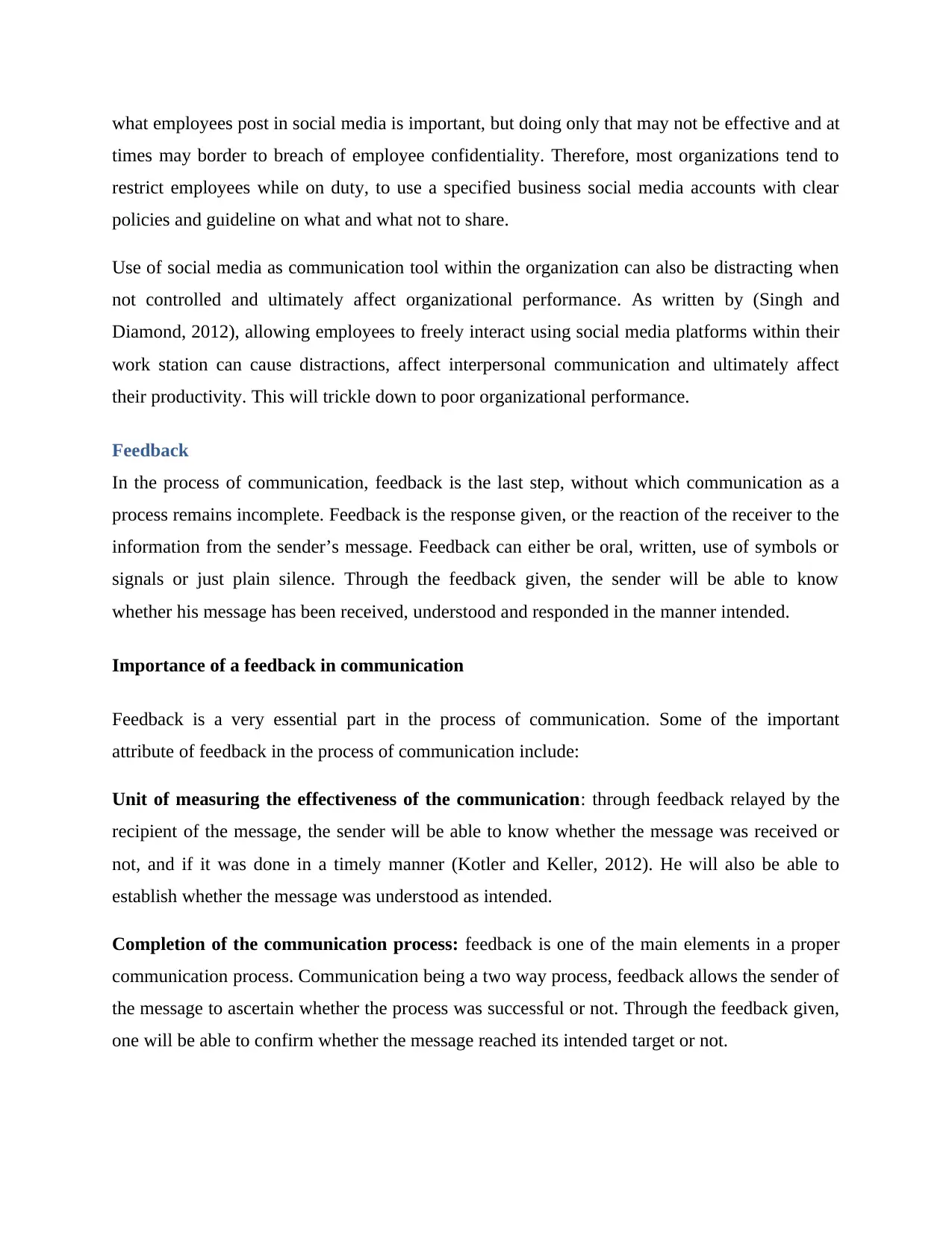
what employees post in social media is important, but doing only that may not be effective and at
times may border to breach of employee confidentiality. Therefore, most organizations tend to
restrict employees while on duty, to use a specified business social media accounts with clear
policies and guideline on what and what not to share.
Use of social media as communication tool within the organization can also be distracting when
not controlled and ultimately affect organizational performance. As written by (Singh and
Diamond, 2012), allowing employees to freely interact using social media platforms within their
work station can cause distractions, affect interpersonal communication and ultimately affect
their productivity. This will trickle down to poor organizational performance.
Feedback
In the process of communication, feedback is the last step, without which communication as a
process remains incomplete. Feedback is the response given, or the reaction of the receiver to the
information from the sender’s message. Feedback can either be oral, written, use of symbols or
signals or just plain silence. Through the feedback given, the sender will be able to know
whether his message has been received, understood and responded in the manner intended.
Importance of a feedback in communication
Feedback is a very essential part in the process of communication. Some of the important
attribute of feedback in the process of communication include:
Unit of measuring the effectiveness of the communication: through feedback relayed by the
recipient of the message, the sender will be able to know whether the message was received or
not, and if it was done in a timely manner (Kotler and Keller, 2012). He will also be able to
establish whether the message was understood as intended.
Completion of the communication process: feedback is one of the main elements in a proper
communication process. Communication being a two way process, feedback allows the sender of
the message to ascertain whether the process was successful or not. Through the feedback given,
one will be able to confirm whether the message reached its intended target or not.
times may border to breach of employee confidentiality. Therefore, most organizations tend to
restrict employees while on duty, to use a specified business social media accounts with clear
policies and guideline on what and what not to share.
Use of social media as communication tool within the organization can also be distracting when
not controlled and ultimately affect organizational performance. As written by (Singh and
Diamond, 2012), allowing employees to freely interact using social media platforms within their
work station can cause distractions, affect interpersonal communication and ultimately affect
their productivity. This will trickle down to poor organizational performance.
Feedback
In the process of communication, feedback is the last step, without which communication as a
process remains incomplete. Feedback is the response given, or the reaction of the receiver to the
information from the sender’s message. Feedback can either be oral, written, use of symbols or
signals or just plain silence. Through the feedback given, the sender will be able to know
whether his message has been received, understood and responded in the manner intended.
Importance of a feedback in communication
Feedback is a very essential part in the process of communication. Some of the important
attribute of feedback in the process of communication include:
Unit of measuring the effectiveness of the communication: through feedback relayed by the
recipient of the message, the sender will be able to know whether the message was received or
not, and if it was done in a timely manner (Kotler and Keller, 2012). He will also be able to
establish whether the message was understood as intended.
Completion of the communication process: feedback is one of the main elements in a proper
communication process. Communication being a two way process, feedback allows the sender of
the message to ascertain whether the process was successful or not. Through the feedback given,
one will be able to confirm whether the message reached its intended target or not.
Paraphrase This Document
Need a fresh take? Get an instant paraphrase of this document with our AI Paraphraser
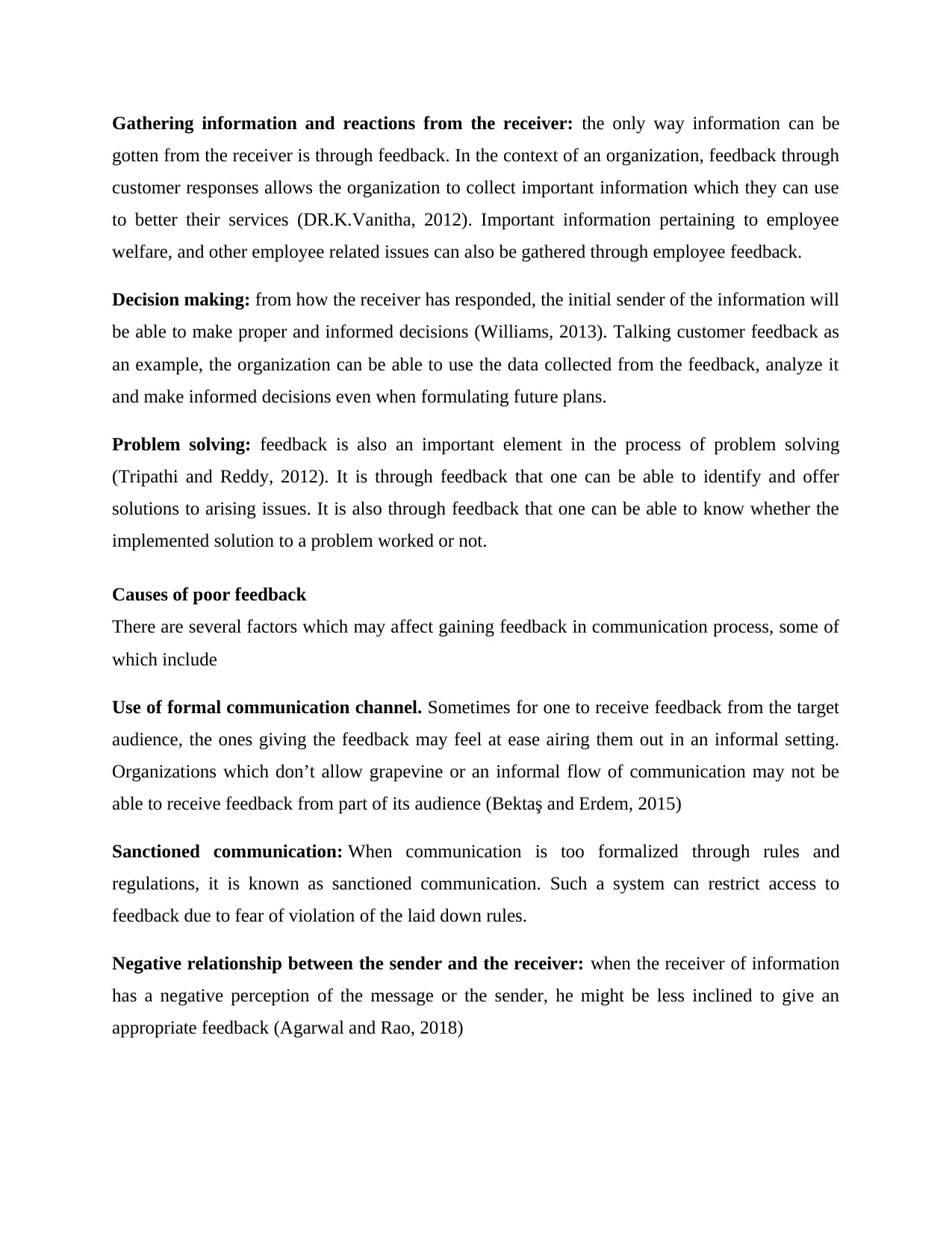
Gathering information and reactions from the receiver: the only way information can be
gotten from the receiver is through feedback. In the context of an organization, feedback through
customer responses allows the organization to collect important information which they can use
to better their services (DR.K.Vanitha, 2012). Important information pertaining to employee
welfare, and other employee related issues can also be gathered through employee feedback.
Decision making: from how the receiver has responded, the initial sender of the information will
be able to make proper and informed decisions (Williams, 2013). Talking customer feedback as
an example, the organization can be able to use the data collected from the feedback, analyze it
and make informed decisions even when formulating future plans.
Problem solving: feedback is also an important element in the process of problem solving
(Tripathi and Reddy, 2012). It is through feedback that one can be able to identify and offer
solutions to arising issues. It is also through feedback that one can be able to know whether the
implemented solution to a problem worked or not.
Causes of poor feedback
There are several factors which may affect gaining feedback in communication process, some of
which include
Use of formal communication channel. Sometimes for one to receive feedback from the target
audience, the ones giving the feedback may feel at ease airing them out in an informal setting.
Organizations which don’t allow grapevine or an informal flow of communication may not be
able to receive feedback from part of its audience (Bektaş and Erdem, 2015)
Sanctioned communication: When communication is too formalized through rules and
regulations, it is known as sanctioned communication. Such a system can restrict access to
feedback due to fear of violation of the laid down rules.
Negative relationship between the sender and the receiver: when the receiver of information
has a negative perception of the message or the sender, he might be less inclined to give an
appropriate feedback (Agarwal and Rao, 2018)
gotten from the receiver is through feedback. In the context of an organization, feedback through
customer responses allows the organization to collect important information which they can use
to better their services (DR.K.Vanitha, 2012). Important information pertaining to employee
welfare, and other employee related issues can also be gathered through employee feedback.
Decision making: from how the receiver has responded, the initial sender of the information will
be able to make proper and informed decisions (Williams, 2013). Talking customer feedback as
an example, the organization can be able to use the data collected from the feedback, analyze it
and make informed decisions even when formulating future plans.
Problem solving: feedback is also an important element in the process of problem solving
(Tripathi and Reddy, 2012). It is through feedback that one can be able to identify and offer
solutions to arising issues. It is also through feedback that one can be able to know whether the
implemented solution to a problem worked or not.
Causes of poor feedback
There are several factors which may affect gaining feedback in communication process, some of
which include
Use of formal communication channel. Sometimes for one to receive feedback from the target
audience, the ones giving the feedback may feel at ease airing them out in an informal setting.
Organizations which don’t allow grapevine or an informal flow of communication may not be
able to receive feedback from part of its audience (Bektaş and Erdem, 2015)
Sanctioned communication: When communication is too formalized through rules and
regulations, it is known as sanctioned communication. Such a system can restrict access to
feedback due to fear of violation of the laid down rules.
Negative relationship between the sender and the receiver: when the receiver of information
has a negative perception of the message or the sender, he might be less inclined to give an
appropriate feedback (Agarwal and Rao, 2018)
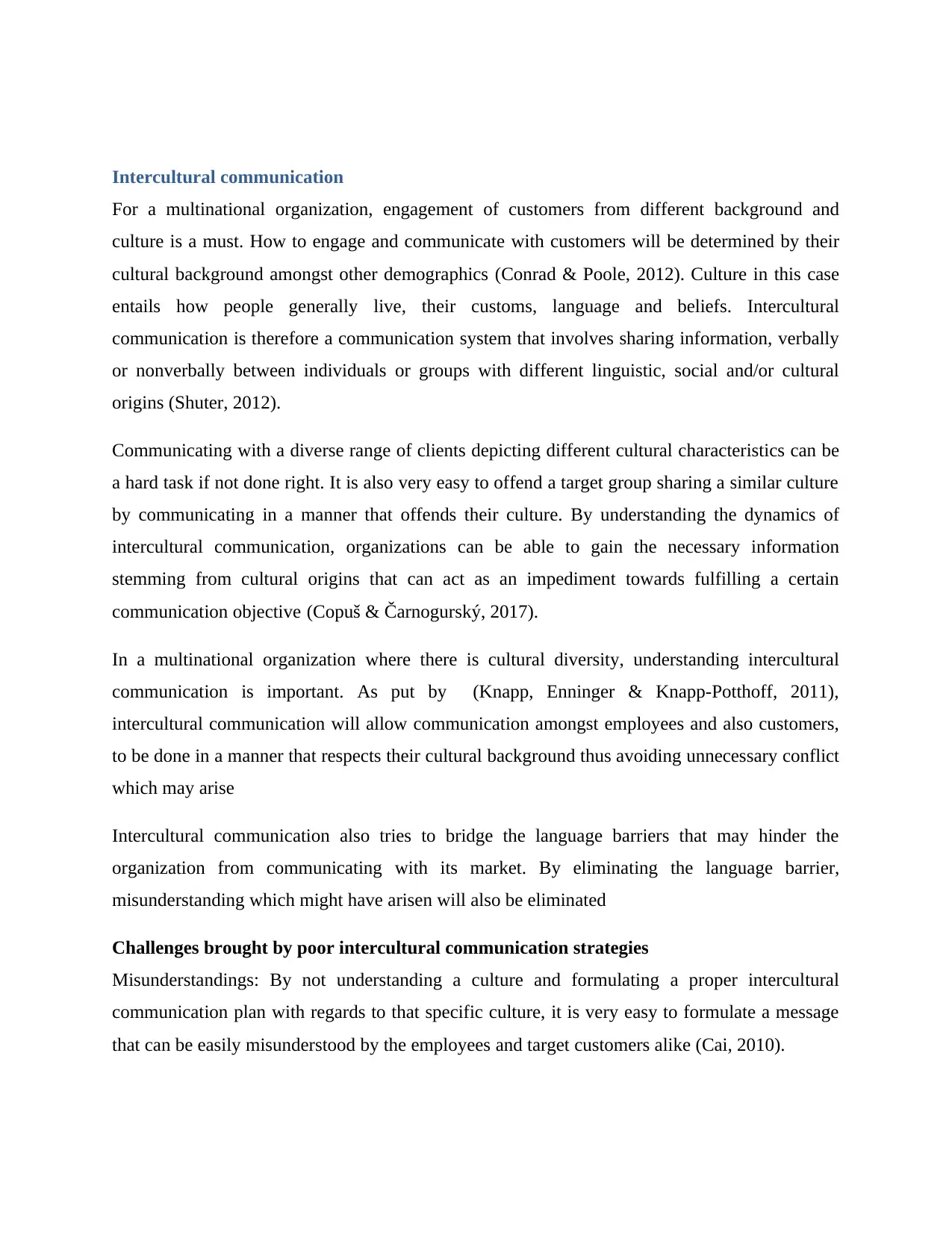
Intercultural communication
For a multinational organization, engagement of customers from different background and
culture is a must. How to engage and communicate with customers will be determined by their
cultural background amongst other demographics (Conrad & Poole, 2012). Culture in this case
entails how people generally live, their customs, language and beliefs. Intercultural
communication is therefore a communication system that involves sharing information, verbally
or nonverbally between individuals or groups with different linguistic, social and/or cultural
origins (Shuter, 2012).
Communicating with a diverse range of clients depicting different cultural characteristics can be
a hard task if not done right. It is also very easy to offend a target group sharing a similar culture
by communicating in a manner that offends their culture. By understanding the dynamics of
intercultural communication, organizations can be able to gain the necessary information
stemming from cultural origins that can act as an impediment towards fulfilling a certain
communication objective (Copuš & Čarnogurský, 2017).
In a multinational organization where there is cultural diversity, understanding intercultural
communication is important. As put by (Knapp, Enninger & Knapp-Potthoff, 2011),
intercultural communication will allow communication amongst employees and also customers,
to be done in a manner that respects their cultural background thus avoiding unnecessary conflict
which may arise
Intercultural communication also tries to bridge the language barriers that may hinder the
organization from communicating with its market. By eliminating the language barrier,
misunderstanding which might have arisen will also be eliminated
Challenges brought by poor intercultural communication strategies
Misunderstandings: By not understanding a culture and formulating a proper intercultural
communication plan with regards to that specific culture, it is very easy to formulate a message
that can be easily misunderstood by the employees and target customers alike (Cai, 2010).
For a multinational organization, engagement of customers from different background and
culture is a must. How to engage and communicate with customers will be determined by their
cultural background amongst other demographics (Conrad & Poole, 2012). Culture in this case
entails how people generally live, their customs, language and beliefs. Intercultural
communication is therefore a communication system that involves sharing information, verbally
or nonverbally between individuals or groups with different linguistic, social and/or cultural
origins (Shuter, 2012).
Communicating with a diverse range of clients depicting different cultural characteristics can be
a hard task if not done right. It is also very easy to offend a target group sharing a similar culture
by communicating in a manner that offends their culture. By understanding the dynamics of
intercultural communication, organizations can be able to gain the necessary information
stemming from cultural origins that can act as an impediment towards fulfilling a certain
communication objective (Copuš & Čarnogurský, 2017).
In a multinational organization where there is cultural diversity, understanding intercultural
communication is important. As put by (Knapp, Enninger & Knapp-Potthoff, 2011),
intercultural communication will allow communication amongst employees and also customers,
to be done in a manner that respects their cultural background thus avoiding unnecessary conflict
which may arise
Intercultural communication also tries to bridge the language barriers that may hinder the
organization from communicating with its market. By eliminating the language barrier,
misunderstanding which might have arisen will also be eliminated
Challenges brought by poor intercultural communication strategies
Misunderstandings: By not understanding a culture and formulating a proper intercultural
communication plan with regards to that specific culture, it is very easy to formulate a message
that can be easily misunderstood by the employees and target customers alike (Cai, 2010).
⊘ This is a preview!⊘
Do you want full access?
Subscribe today to unlock all pages.

Trusted by 1+ million students worldwide
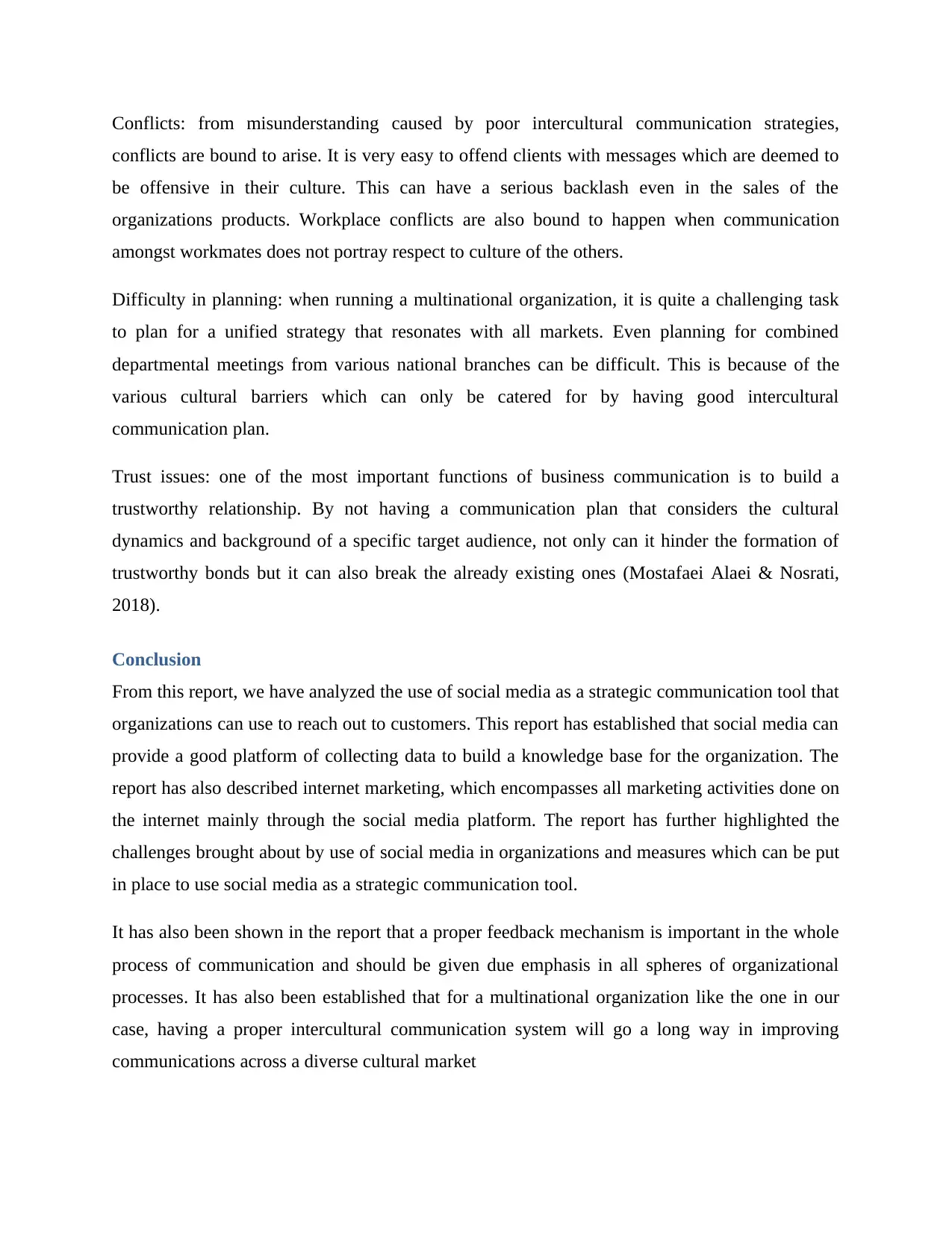
Conflicts: from misunderstanding caused by poor intercultural communication strategies,
conflicts are bound to arise. It is very easy to offend clients with messages which are deemed to
be offensive in their culture. This can have a serious backlash even in the sales of the
organizations products. Workplace conflicts are also bound to happen when communication
amongst workmates does not portray respect to culture of the others.
Difficulty in planning: when running a multinational organization, it is quite a challenging task
to plan for a unified strategy that resonates with all markets. Even planning for combined
departmental meetings from various national branches can be difficult. This is because of the
various cultural barriers which can only be catered for by having good intercultural
communication plan.
Trust issues: one of the most important functions of business communication is to build a
trustworthy relationship. By not having a communication plan that considers the cultural
dynamics and background of a specific target audience, not only can it hinder the formation of
trustworthy bonds but it can also break the already existing ones (Mostafaei Alaei & Nosrati,
2018).
Conclusion
From this report, we have analyzed the use of social media as a strategic communication tool that
organizations can use to reach out to customers. This report has established that social media can
provide a good platform of collecting data to build a knowledge base for the organization. The
report has also described internet marketing, which encompasses all marketing activities done on
the internet mainly through the social media platform. The report has further highlighted the
challenges brought about by use of social media in organizations and measures which can be put
in place to use social media as a strategic communication tool.
It has also been shown in the report that a proper feedback mechanism is important in the whole
process of communication and should be given due emphasis in all spheres of organizational
processes. It has also been established that for a multinational organization like the one in our
case, having a proper intercultural communication system will go a long way in improving
communications across a diverse cultural market
conflicts are bound to arise. It is very easy to offend clients with messages which are deemed to
be offensive in their culture. This can have a serious backlash even in the sales of the
organizations products. Workplace conflicts are also bound to happen when communication
amongst workmates does not portray respect to culture of the others.
Difficulty in planning: when running a multinational organization, it is quite a challenging task
to plan for a unified strategy that resonates with all markets. Even planning for combined
departmental meetings from various national branches can be difficult. This is because of the
various cultural barriers which can only be catered for by having good intercultural
communication plan.
Trust issues: one of the most important functions of business communication is to build a
trustworthy relationship. By not having a communication plan that considers the cultural
dynamics and background of a specific target audience, not only can it hinder the formation of
trustworthy bonds but it can also break the already existing ones (Mostafaei Alaei & Nosrati,
2018).
Conclusion
From this report, we have analyzed the use of social media as a strategic communication tool that
organizations can use to reach out to customers. This report has established that social media can
provide a good platform of collecting data to build a knowledge base for the organization. The
report has also described internet marketing, which encompasses all marketing activities done on
the internet mainly through the social media platform. The report has further highlighted the
challenges brought about by use of social media in organizations and measures which can be put
in place to use social media as a strategic communication tool.
It has also been shown in the report that a proper feedback mechanism is important in the whole
process of communication and should be given due emphasis in all spheres of organizational
processes. It has also been established that for a multinational organization like the one in our
case, having a proper intercultural communication system will go a long way in improving
communications across a diverse cultural market
Paraphrase This Document
Need a fresh take? Get an instant paraphrase of this document with our AI Paraphraser
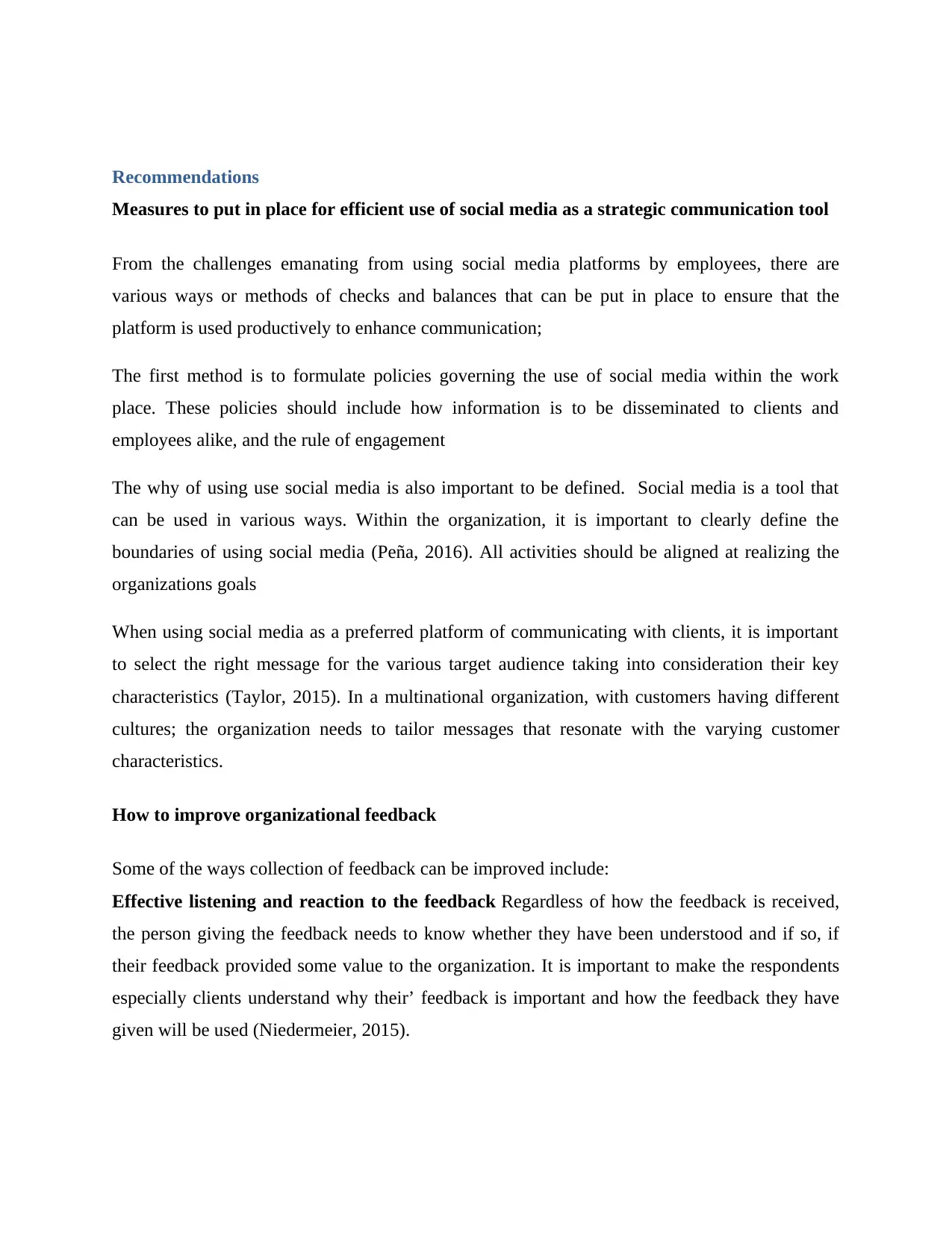
Recommendations
Measures to put in place for efficient use of social media as a strategic communication tool
From the challenges emanating from using social media platforms by employees, there are
various ways or methods of checks and balances that can be put in place to ensure that the
platform is used productively to enhance communication;
The first method is to formulate policies governing the use of social media within the work
place. These policies should include how information is to be disseminated to clients and
employees alike, and the rule of engagement
The why of using use social media is also important to be defined. Social media is a tool that
can be used in various ways. Within the organization, it is important to clearly define the
boundaries of using social media (Peña, 2016). All activities should be aligned at realizing the
organizations goals
When using social media as a preferred platform of communicating with clients, it is important
to select the right message for the various target audience taking into consideration their key
characteristics (Taylor, 2015). In a multinational organization, with customers having different
cultures; the organization needs to tailor messages that resonate with the varying customer
characteristics.
How to improve organizational feedback
Some of the ways collection of feedback can be improved include:
Effective listening and reaction to the feedback Regardless of how the feedback is received,
the person giving the feedback needs to know whether they have been understood and if so, if
their feedback provided some value to the organization. It is important to make the respondents
especially clients understand why their’ feedback is important and how the feedback they have
given will be used (Niedermeier, 2015).
Measures to put in place for efficient use of social media as a strategic communication tool
From the challenges emanating from using social media platforms by employees, there are
various ways or methods of checks and balances that can be put in place to ensure that the
platform is used productively to enhance communication;
The first method is to formulate policies governing the use of social media within the work
place. These policies should include how information is to be disseminated to clients and
employees alike, and the rule of engagement
The why of using use social media is also important to be defined. Social media is a tool that
can be used in various ways. Within the organization, it is important to clearly define the
boundaries of using social media (Peña, 2016). All activities should be aligned at realizing the
organizations goals
When using social media as a preferred platform of communicating with clients, it is important
to select the right message for the various target audience taking into consideration their key
characteristics (Taylor, 2015). In a multinational organization, with customers having different
cultures; the organization needs to tailor messages that resonate with the varying customer
characteristics.
How to improve organizational feedback
Some of the ways collection of feedback can be improved include:
Effective listening and reaction to the feedback Regardless of how the feedback is received,
the person giving the feedback needs to know whether they have been understood and if so, if
their feedback provided some value to the organization. It is important to make the respondents
especially clients understand why their’ feedback is important and how the feedback they have
given will be used (Niedermeier, 2015).
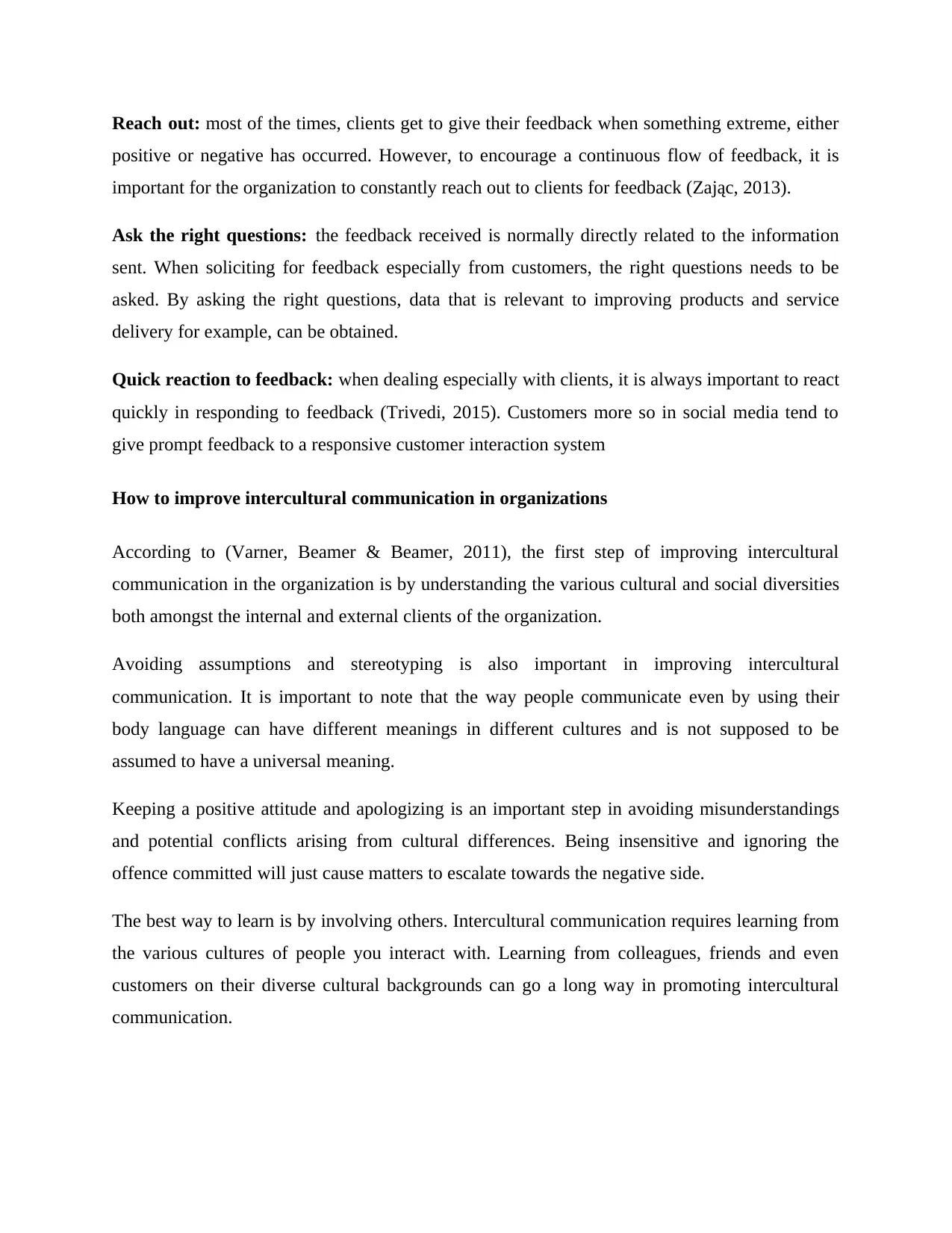
Reach out: most of the times, clients get to give their feedback when something extreme, either
positive or negative has occurred. However, to encourage a continuous flow of feedback, it is
important for the organization to constantly reach out to clients for feedback (Zając, 2013).
Ask the right questions: the feedback received is normally directly related to the information
sent. When soliciting for feedback especially from customers, the right questions needs to be
asked. By asking the right questions, data that is relevant to improving products and service
delivery for example, can be obtained.
Quick reaction to feedback: when dealing especially with clients, it is always important to react
quickly in responding to feedback (Trivedi, 2015). Customers more so in social media tend to
give prompt feedback to a responsive customer interaction system
How to improve intercultural communication in organizations
According to (Varner, Beamer & Beamer, 2011), the first step of improving intercultural
communication in the organization is by understanding the various cultural and social diversities
both amongst the internal and external clients of the organization.
Avoiding assumptions and stereotyping is also important in improving intercultural
communication. It is important to note that the way people communicate even by using their
body language can have different meanings in different cultures and is not supposed to be
assumed to have a universal meaning.
Keeping a positive attitude and apologizing is an important step in avoiding misunderstandings
and potential conflicts arising from cultural differences. Being insensitive and ignoring the
offence committed will just cause matters to escalate towards the negative side.
The best way to learn is by involving others. Intercultural communication requires learning from
the various cultures of people you interact with. Learning from colleagues, friends and even
customers on their diverse cultural backgrounds can go a long way in promoting intercultural
communication.
positive or negative has occurred. However, to encourage a continuous flow of feedback, it is
important for the organization to constantly reach out to clients for feedback (Zając, 2013).
Ask the right questions: the feedback received is normally directly related to the information
sent. When soliciting for feedback especially from customers, the right questions needs to be
asked. By asking the right questions, data that is relevant to improving products and service
delivery for example, can be obtained.
Quick reaction to feedback: when dealing especially with clients, it is always important to react
quickly in responding to feedback (Trivedi, 2015). Customers more so in social media tend to
give prompt feedback to a responsive customer interaction system
How to improve intercultural communication in organizations
According to (Varner, Beamer & Beamer, 2011), the first step of improving intercultural
communication in the organization is by understanding the various cultural and social diversities
both amongst the internal and external clients of the organization.
Avoiding assumptions and stereotyping is also important in improving intercultural
communication. It is important to note that the way people communicate even by using their
body language can have different meanings in different cultures and is not supposed to be
assumed to have a universal meaning.
Keeping a positive attitude and apologizing is an important step in avoiding misunderstandings
and potential conflicts arising from cultural differences. Being insensitive and ignoring the
offence committed will just cause matters to escalate towards the negative side.
The best way to learn is by involving others. Intercultural communication requires learning from
the various cultures of people you interact with. Learning from colleagues, friends and even
customers on their diverse cultural backgrounds can go a long way in promoting intercultural
communication.
⊘ This is a preview!⊘
Do you want full access?
Subscribe today to unlock all pages.

Trusted by 1+ million students worldwide
1 out of 14
Related Documents
Your All-in-One AI-Powered Toolkit for Academic Success.
+13062052269
info@desklib.com
Available 24*7 on WhatsApp / Email
![[object Object]](/_next/static/media/star-bottom.7253800d.svg)
Unlock your academic potential
Copyright © 2020–2025 A2Z Services. All Rights Reserved. Developed and managed by ZUCOL.





